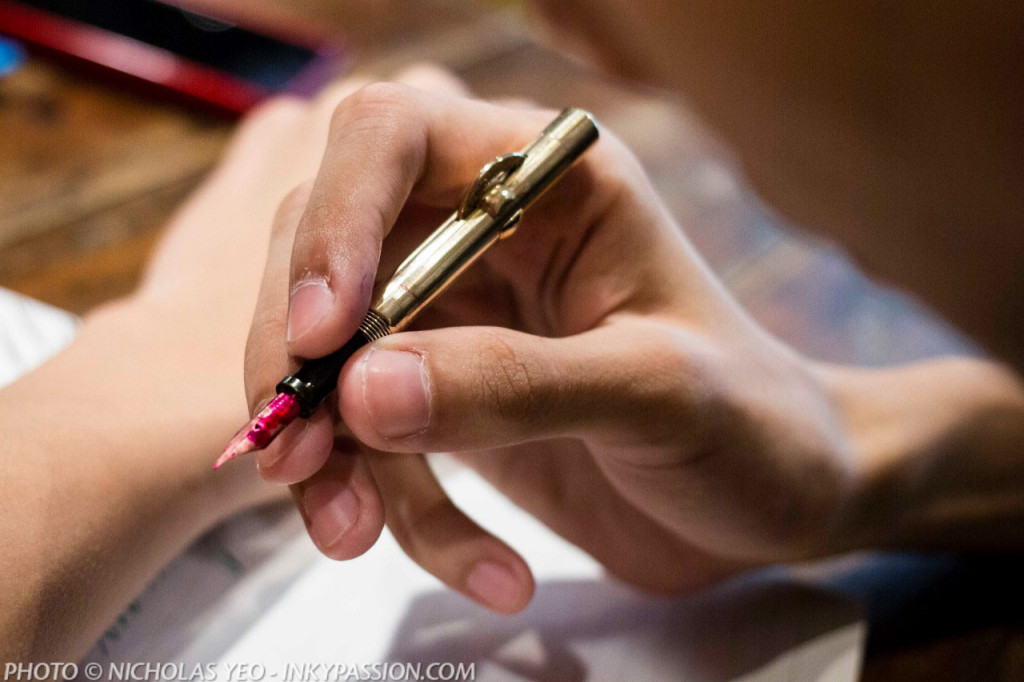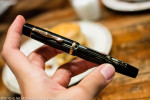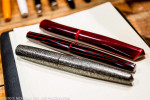Every so often I meet up with a small group of friends who are fountain pen collectors, and we spend a weekend afternoon over coffee. It is enjoyable to learn about all kinds of fine writing instruments, whether they are the most exquisite vintages or modern day marvels. The following photos illustrate just some of the notable pens in their collection.
1925 – Gold-Filled Conklin Crescent Filler
The Conklin Crescent Filler was the first self-filling fountain pen to be mass produced. Designed by pioneer pen maker Roy Conklin, the singular Crescent Filler was granted patents in 1901 and 1903. It continued to be manufactured until 1930, the year it was finally retired in favour of the more advanced lever-filling system.
In order to fill a Crescent Filler, the user spins the circular bead to line it up with the crescent fill button. When the two are aligned, the pen is submerged in ink and the crescent is depressed. This compresses and decompresses the sac, allowing it to fill with ink. The Crescent Filler is much like a lever-filler with a literal twist.
Conklin made a huge variety of models, and not all are known or available even to the most discerning collectors. Fortunately, the Crescent Filler has seen a revival and details are available from their online site. The company has also expanded their range of offerings to include other designs which have been refreshed for the modern user.
1930s – Wahl-Eversharp Doric
First introduced in 1931, the Wahl-Eversharp Doric is unmistakable in its faceted Art Deco styling. The twelve-sided barrel tapers at both ends, much like the Omas Paragon which was released at about the same time. There is still much debate about which came first.
What is certain is that Wahl-Eversharp was the innovator when it came to nibs – from 1932, the Doric featured an ingenious “adjustable nib”. Fitted with a tiny slider, the adjustable nib allowed users to increase and decrease the flexibility of the nib. Moving the slider towards the section increased flexibility while the reverse made the nib rigid.
The Wahl- Eversharp Doric was the inspiration for the Pilot Justus, which improved upon its design in the addition of a screw-operated “tension adjuster”. This did away with the need for users to touch the nib.
1930s – Waterman Ink-Vue
First released in 1936, the Ink-Vue was Waterman’s answer to the hugely popular Parker Vacumatic. The Ink-Vue is constructed from celluloid, and is easily distinguished by the criss-cross pearlescent strips which adorn its barrel.
As its name suggests, the pen features a translucent barrel which allows users to view the remaining ink capacity. The bulb-filler fountain pen comes in a number of colours – the Copper Ray, Emerald Ray and Silver Ray are seen here. For those who are interested, a comprehensive article detailing the history of the Ink-Vue is available on Richards Pens.

1936 – Mont Blanc Meisterstück 128PL
The Mont Blanc 128PL was produced from the years 1935 to 1938. It is highly sought after by collectors today and has appeared in numerous auction catalogues such as those from Christies and Bonhams. The 128PL is made of platinum pearl striped silver-grey celluloid, while the cap top and endpiece are made of black hard rubber.
The cap band and “tie” style clip are gold plated, while the nib is made of two-tone gold. The 128PL is operated by a push-button filling system. Pushing the button atop the barrel compresses a rubber ink sac, which creates suction and allows the pen to fill with ink. The words 128PL simply refer to the specifications of the pen – 1 (Meisterstück) 2 (push button filler) 8 (size) PL (platinum lined celluloid.

1950s – Mont Blanc 214 Coral Red (Denmark)
The Mont Blanc 214 is an extremely rare fountain pen. The 214 is constructed from coral red celluloid and was manufactured by the Danish Mont Blanc factory exclusively for the local market. The push-button sac filler is operated by unscrewing the barrel cap. Fitted with a semi-flexible nib, the 214 was produced for a period of approximately one two years.
A majority of Mont Blanc pens manufactured in the late 1940s and early 1950s were made in Denmark, as a result of restrictions imposed on the import and export of precious metals at the end of World War II.
The Mont Blanc plant in Denmark had been operational since 1914, but it was a well-kept secret. Few had knowledge of the company’s collaboration with Alfred Olberg until much later in 1964. The history of Mont Blanc in Denmark is the subject of a book by Claus Holten and Pold Lund titled “Montblanc in Denmark 1914 – 1992 The Untold Story”.
Enjoy the remaining photographs!




























